SEA TROUT FYN







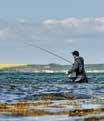













Here, you can find everything you need in your quest for sea trout – apart from the salt water!
Check out the interactive map of the 1,100 kilometres of sea trout coastline. EVERYTHING you need has been brought together on one sea trout map. There are 117 fishing spots with satellite photos, topographical maps, descriptions of fishing spots, seasonal recommendations, conservation zones, special rules, etc. – all right at your fingertips whenever you need it! You can also:
Find accommodation at a certified anglers’ establishment. Book the island’s best sea trout angler as your own guide. Watch a video about fishing for sea trout. Follow our work to promote Fyn’s sea-trout stocks. Read news from the coasts, the fishing guides and partners. Gain new knowledge about sea trout and practical fishing. See conservation zone information and fishing rules for Fyn’s coastlines.

As we here at Havørred Fyn (Sea Trout Fyn) cast our minds back over 2022, there is certainly no denying it was a busy year. Our new Havørred Fyn Strategy 2022–2026 was adopted, and we are now working full swing now to roll it out into reality. The strategy connects our three primary areas of action: stream restoration, increasing sea trout numbers and the marketing/promo-

tion of fishing tourism. We have had some new recruits join the project. In March 2022, Havørred Fyn welcomed on board a new PR & Marketing Coordinator, Christian Thomsen, who has been working full-time on the project since August.
Christian has a background within nature and culture communications and he holds a Master’s Degree in Sustainable Tourism from Aalborg University. Despite his young age of 28 years, Christian has already worked with hunting, fishing and outdoor tourism in several places across the globe. Christian grew up in Southern Jutland and he studied in Jutland. He now lives on Fyn, close to some of the best spots for sea trout in all the country.
I have always fished. I don’t even remember when it started. But the water has always looked a little bluer on the other side, so I’ve travelled plenty and fished sharks in New Zealand, halibut and grayling in the Saltstraumen Strait in Norway, rainbow trout in Canada, and most recently, I developed fishing expeditions for Albatros Expeditions in Greenland. For me, there’s simply nothing better than a good day on the coast fishing for sea trout. So I am incredibly grateful for my new position with Havørred Fyn.”
- Christian ThomsenHavørred Fyn is set to continue its good work in 2023, and a particularly exciting year appears to be in store. We have begun our large marking experiment, which you can read more about in this magazine – including how you can help. We are looking forward to a lot of exciting projects, and the recently revived Fynske Grusbande (Gravel Gang) is also ramping up their activities, offering another chance for you to get involved. At the same time, we are also hoping to see a lot more sea-trout tourists along the coasts of Fyn, Langeland and Ærø. Fishing tourists help to support the project and ensure that we have a reason to keep on doing what we do. They contribute to the local economy and, just like our local anglers, they treat our sea trout with great respect, returning the majority of their catches. Fyn has more than 1,100 kilome-
tres of coastline so there is ample space for everyone.
Here at Havørred Fyn, we take great pride in getting across the right information to the right people. That is where we want our expertise to lie. More focus will be placed on the release of smaller and larger fish, learning, experiences, handling catches and taking a sustainable approach to our sea trout communications. After all, not all places are able to support increasing demand from anglers. The seatrout.dk website and its familiar interactive fishing map will be getting an upgrade in 2023, so they will be even better. And we will also be working to build and cultivate even closer links with our partners and the many volunteers involved in the project, who together help to make Fyn a real El Dorado for all things sea trout.
Best of luck out there along the coasts of Fyn!

Publisher: Sea Trout Fyn / www.seatrout.dk
Editor: Christian Thomsen
Print run: 15.000 in Danish, German and English versions
Print: Johnsen Graphic Solutions A/S
Translation: Diction APS
Layout: www.anglingconsulting.one v. O. Gade.
Photos: Johannes Arlt, Jahr Media/ F. Pippardt, Linda B. Høgh, Peter Sikking, Aart-Jan V. Mossel, Terkel B. Christensen, Johannes Radtke, Matthias Arnham, Omar B. Gade, Freja K. Christlieb , Christian Thomsen, Søren Bay, Søren Skarby, EHF, DTU
Cover: Andreas Lindquist
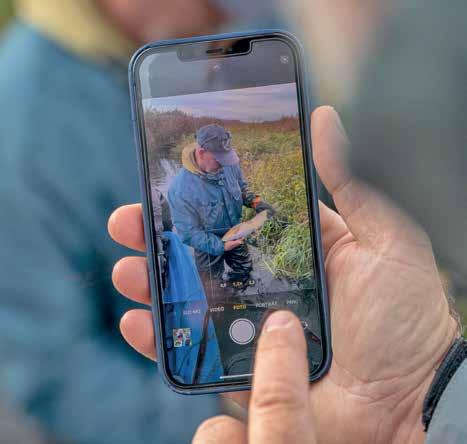


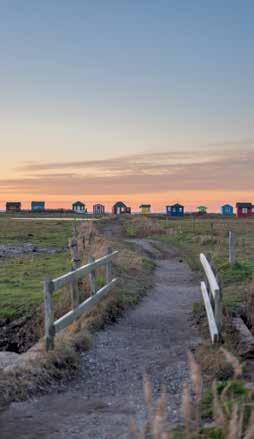



Havørred Fyn (Sea Trout Fyn) has helped to create top-class conditions for sea trout fishing by European standards. The project’s unique link between tourism development and environmental regeneration has helped pitch Fyn as a green island and an attractive tourist destination – especially outside of high season!
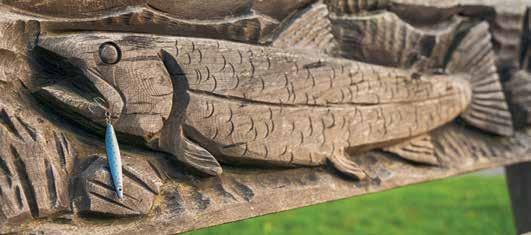
The original idea behind the Havørred Fyn project was to develop sea trout fishing tourism on Fyn and the Islands through nature conservation in the form of stream restoration and the release of smolt. The idea was that, by putting effort into restoring steams and brooks to good condition, and by releasing smolt, we could bolster the foundations needed for solid fishing tourism. Sound fishing tourism generates a sound economy – and a sound economy is a strong motivating factor to invest yet even more in efforts that will improve our streams and watercourses
It all began for Havørred Fyn back in
1990. The former Fyn County undertook a range of initiatives aimed at promoting business on Fyn. The idea was to create more jobs, especially on the smaller islands. One of the initiatives was Havørredeldorado Fyns Amt [Sea Trout El Dorado, Fyn County]. In the 1990s, the watercourses on Fyn were by no means something to brag about. Blockages from water mills and meadow irrigation systems had become a ‘natural’ occurrence, and there was no shortage of piped sections and drops. Moreover, water was often underappreciated and sewage discharge
directly into our watercourses had unfortunately become par for the course. Back then, most anglers fished for cod, flatfish and garfish. Finding a sea trout was a special but seldom occurrence. And so Fyn County saw an opportunity to kill two birds with one stone through their El Dorado project. The project has since changed its name to the much simpler Havørred Fyn that we know today, bringing all ten municipalities on Fyn together to make a unified and concerted green effort across administrative boundaries.


Today, more than thirty years later, those early ambitions of the project have succeeded beyond all expectations. Fish living conditions have improved considerable in many of our watercourses. This was the result of a huge effort to remove the blockages that prevented sea trout from reaching their spawning grounds, and of laying out spawning gravel and hiding stones

in places where the water had removed them over time. Alongside the release of hundreds of thousands of smolt each year, this huge effort has helped to make Fyn, Langeland and Ærø into top-class fishing destinations. Angling along the coasts of Fyn is something that experts are discussing and writing about both locally and internationally, and not without good reason. The Havørred Fyn model has spread and that is fantastic. However, there is still plenty of scope
for us to roll up our sleeves and keep on doing the good work that all our volunteers, associations and others have been helping with. Streams run through our region like nature’s veins, and there are still plenty of ‘blood clots’ that could be removed. Without the tremendous support of its volunteers, Havørred Fyn would never be able to run. But so long as it is here, we can continue to enjoy the excellent sea trout fishing that Fyn and the Islands have to offer.


Every year, thousands of sea trout make their way from the sea and the fjords into our streams and brooks to spawn. Cock and hen fish come together to spawn in so-called spawning pits that the hen fish dig by fiercely shaking their tail fin. After spawning, the female fish then use their tail fin to cover the fertilized eggs with small stones, so they are well protected at the bottom of the water until spring.
Fyns Laksefisk catches some of these sea trout that are spawning. They do this via electrofishing which involves using electricity to create an electric field that briefly paralyses the fish and allows them to be easily caught. These breeding females are taken back to the hatchery where they are stripped of their eggs and sperm while still paralysed. The spawning process is then recreated artificially, with the eggs being placed in hatching trays. These are the hatchery’s answer to spawning pits.
The fertilised eggs first become eyed eggs and after several months, they hatch as small fish larvae. These are known as ‘yolk-sac fry’ and for the first few weeks they have their very own food pack in their stomachs. Af-
ter that runs out, fry in the wild start looking for food themselves, while in the hatchery, feeding begins.
Light conditions at Fyns Laksefisk’s breeding facilities follow seasonal variations through the use of a lighting control system. Great efforts are also made to get the temperature in the facilities to follow the seasonal temperatures outside. All so that the fish are raised in as natural a way as possible.
Young sea trout spend approximately one year in the watercourses, through until the following spring. By this time, they will have reached a size of 15–17 cm and the majority will now make their way out into the salty sea.
In the intervening period, they undergo several physical changes in the water courses, smoltification, which allows them to survive in the salt water. The most obvious change is that they become completely silvery.

The trout raised at Fyns Laksefisk are released (or stocked) into the estuaries in the spring, at the same time as the natural smolt migrate towards the sea. The idea is that the farmed sea trout follow the natural life cycle of a sea trout and migrate to sea themselves. For this reason, it is
crucial that they have also undergone the necessary physical changes at the breeding facilities. And precisely because the light and temperature conditions reflect those in nature, the smoltification process is able to take place in the breeding facilities as well. They also go nice and shiny!
And with that, the next generation of sea trout on the coast is secured and the cycle continues. At sea, the trout grow very quickly. A smolt that measures around 15 centimetres in the spring will be over the minimum size by the following spring, when the next generation of smolt are on their way out to sea.
In nature, only the fittest survive. There is no mercy. Figures show that only 1.5% of wild sea trout survive their first year in nature. And even if nature and culture rarely compare, survival at the hatchery is 75% for the first year. But what about the difference between wild and stocked fish once both are out on the coast? A new large-scale marking experiment can hopefully answer that question, and Havørred Fyn needs your help with it!
1: Sea trouts have growth rings on their scales, a little like the annual rings of a tree. These allow us to determine the age of a sea trout
2: A female sea trout can produce around 2000 eggs per kilo of fish
3: Sea trout, brown trout and lake trout are all the same. It is their habitat that determines what we call them
In collaboration with Fyns Laksefisk and DTU Aqua, Havørred Fyn (Sea Trout Fyn) is commencing history’s largest ever sea trout marking project in Denmark. From spring 2023, all sea trout smolt released in Fyn, Langeland and Ærø will be marked. Anglers will then catch both marked and unmarked fish in the future, and they can assist in data collection efforts by registering the fish they catch. With the help of anglers, we can therefore acquire better knowledge about the effect that release efforts are having.
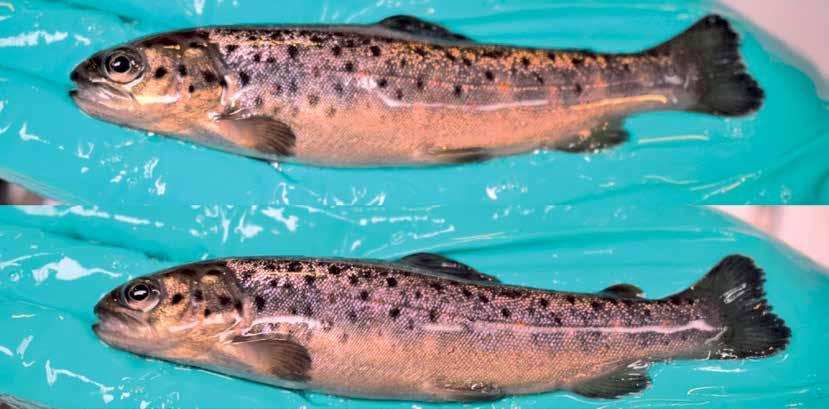
One of the main activities undertaken by Havørred Fyn has for many years been its support releases of sea trout smolt. The

purpose of this is to ensure large sea trout stocks in order to support the solid reputation for sea trout angling that Fyn and the islands enjoy today.
Through watercourse restorations, Havørred Fyn, as well as our volunteers and partners, make a huge effort to strengthen the wild stocks
of sea trout we have in our waters. The vision at Havørred Fyn is to phase out our annual releases as natural production continues to rise. But conditions for sea trout are subject to constant change and it is hugely important that we follow the effects of our many efforts. Including the support releases.
Here on Fyn, we have a clear ambition to make all of our sea trout streams into optimal spawning and rearing streams. The day that goal is reached, we will be able to enjoy excellent coastal fishing based entirely on wild fish. However we are not quite there yet, and until that time comes, it is important that we continue to provide support in the form of fish releases that ultimately originate from wild breeding trout. Marking these fish makes a lot of sense. It allows anglers to distinguish them from wild fish. So you can take stocked fish home to your kitchen with a clear conscience, and release all the wild fish you catch. This is fishing at its most sustainable.”
- Claus Eriksen, Chairman of the Havørred Fyn Advisory Board.Throughout the entire course of the project, the trout smolt are reared at Fyns Laksefisk. The smolt being released in 2023 all originate from breeding fish caught via electrofishing in local waters in 2021. Marking of all the 350,000+ sea trout being released in the spring will also be undertaken locally at Fyns Laksefisk. Fyns Laksefisk is a modern landbased fish farm where marking can be undertaken un a controlled way, using large numbers of volunteers to
help with the process. The marking process involves manually clipping the trout’s adipose fin, which will not grow back. This is a fast process during which the trout are stunned and suffer no harm. Fin clipping is a tried-and-tested method for marking fish that has previously been used for other stocking efforts in Denmark and is used today for salmon in the streams of West Jutland. Havørred Fyn releases over 350,000 sea trout smolt at the mouths of several watercourses on Fyn, Langeland and Ærø. Havørred Fyn is not the only actor releasing fish on Fyn and the Islands. Trout smolt are also reared and released using the funds raised from the compulsory fishing licence. These extra trout will also be marked, so that all trout released between 2023 and 2025 can be distinguished from wild trout. This way, the project will be able to contribute more general knowledge about the effect of support releases and it can also help us better understand how many released sea trout that reach their minimum size are caught by anglers. The initiative will also help us better understand sea
trout migration patterns and the percentage breakdown between the wild and stocked sea trout that are caught.

It is important that our actions generate results, and these results need to be documented and measurable. That way, we can be sure that our efforts are having the greatest possible effect, and we can be certain we are moving in the right direction. Havørred Fyn has marked fish before, but never on such a large scale as this.”
 - Havørred Fyn Secretariat
- Havørred Fyn Secretariat
Fact box: Fishing licence funds refers to the money generated from the sale of fishing licences. Fishing licences are mandatory to fish in Denmark for people aged 18–65 and can be purchased via www.fisketegn.dk
A common side-effect of captive breeding is that the pectoral fins
of the fish will curl. Whereas wild trout will have pectoral fins that are straight and pointy. However, this is not something we can rely on 100%. During electrofishing, checks are made to see whether the fish caught are wild or fish that had been previously released. This is because we only want to use wild fish for breeding. A curled fin comes with great uncertainty, however, and so there remains a risk that stocked fish are caught and included. A missing fin, on the other hand, cannot be mistaken, so this increases our certainty that all breeding fish are wild, and it also means that handling can be minimised to a large extent.
The study, which is being carried out by Fyns Laksefisk, DTU Aqua and Havørred Fyn, has the potential to be one of the most extensive and thorough studies into what proportion of the fish caught by anglers is made up of stocked sea trout. This knowledge will be key to streamlining and supporting future releases. Not just on Fyn and the Islands, but all across Denmark. However, the success of the initiative will hing on data regarding whether the sea trout caught at a particular destination are marked
or not, and this is where anglers can play a crucial role.
Anglers are asked to supply the project with data. DTU Aqua already leads a citizen-science project which allows anglers to contribute their knowledge of Danish fish stocks by recording their fishing trips on an app called Fangstjournalen. Basically, the app allows anglers to keep a fishing diary which allows them to acquire better insights into their own fishing practice and results.
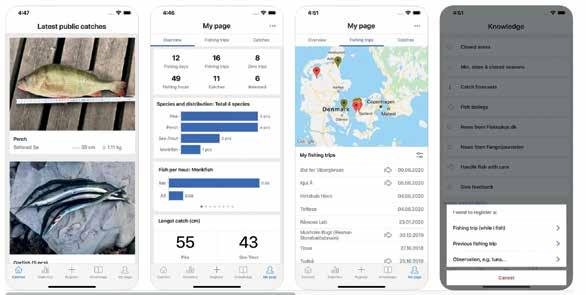
From Spring 2023, users of the Fangstjournalen app will be asked to report whether the sea trout they catch still have their adipose fins or not. The hope is that everyone who fishes sea trout on Fyn and the Islands will contribute data to the study by reporting their fishing trips and catches, with and without adipose fins. In order to further strengthen the database, a key team of skilled anglers will be assembled and report all their trips and catches so that the data can later be compared. Havørred Fyn expects that the first marked trout will be caught and reported via Fangstjournalen over the course of summer 2023 and that
marked sea trout will first begin to reach the minimum size around the start of 2024.
Around DKK 3.5 million is spent each year on the release of trout smolt in Denmark under Fiskeplejen. Our knowledge about the effect of these efforts – including the extent to which they help improve angling conditions – is sparse. That is why this study is particularly important, not just for Havørred Fyn, but for Fiskeplejen more generally.”
- Anders Koed, Professor and Section Leader at DTU Aqua.Help us to help the wild fish – Marking wild fish is good for more than just research. Marking released fish makes it easier for anglers to make an ethical and sustainable choice to release wild sea trout with their adipose fins intact, and – if they want –to take home sea trout without their adipose fins. This will accelerate the process of improving wild sea trout stocks and thus ensure an even more sustainable future for angling.

So join many of your fellow anglers in Denmark and start recording your fishing trips in Fangstjournalen. That way, you can help generate important data about angling and fish stock conditions. From 2023, it will be possible to record whether caught sea trout have their adipose fins or not, and thus help us acquire crucial information about the value of release efforts.
This is how you can share your knowledge:
1.Download and install the Fangstjournalen app. You will find it on Google Play or the App Store.

2.Create your own personal user profile.
3.Record all your fishing trips and catches in Fangstjournalen – including trips when you don’t catch anything, that is also important information for us to know.
4.Record any sea trout you catch. Remember to specify whether it was clipped or not. It is very important that all sea trout – both WITH and WITHOUT their adipose fins – are recorded.


5.You can also record the size, location and time. It is then up to you whether you want to share all this information with your fishing buddies, or let it be known only to science!
Register your catches with ease! – It’s the best!
Fangstjournalen is also available via the FishingInDenmark app.
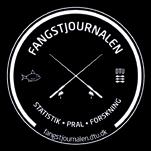

Each year, hundreds of volunteers and different organisations work to improve the conditions for fish in our watercourses. Fangstjournalen is an important tool for documenting the effect of the extensive work carried out.Christian Skov, Associate Professor at DTU Aqua.

Each time sea trout smolt are released around Fyn, Langeland and Ærø, they are helped along their way by hundreds of local volunteers and passionate souls who act as living scarecrows all along the local watercourses. They are the heroes that we call our smolt guardians!
Each April, just as the beech trees are bursting into leaf in, hundreds of thousands of small sea trout are released into the mouths of many watercourses across Fyn, Langeland and Ærø. The fish have been bought and ordered by Havørred Fyn (Sea Trout Fyn), but it is Fyns Laksefisk that has reared, cared for and looked after them for the last year and a half. It is also the good folk at Fynsk Laksefisk who drive out and release these small sea trout into the wild. And they have been doing this for many years with great success. However, in recent years, more focus has been placed on the many challenges that these small and relatively helpless sea trout must face when they are released into the big, wide world. Their new surroundings are in no way comparable to the world they know back at Fyns Laksefisk. Like so many other animals in Denmark’s natural environments, they face no shortage of predators waiting to make these small fish into their next meal. Cormorants, gulls and herons are particularly interested in these small and confused little fish who make for a particularly easy dinner those first few hours after they are released. Especially because they swim around in large shoals and splash about at the surface – a habit from the fish
farm, but by no means a strategy that any wild sea trout smolt would ever use. However, they do adapt relatively quickly to their new surroundings and make their way out to sea. Out in the open waters their chances of survival are much greater, but they need a little help along the way there. That is what our smolt guardians do. Smolt guardians are volunteer anglers, water conservationists and others who sign up to stand guard along local watercourses and scare off smolt predators. For predators are in no short supply, and being a smolt guardian is a simple task that makes a huge difference. It is a way to keep predators at bay without the need for more disruptive interventions. And it is not just the newly released smolt who benefit from these efforts. The wild smolt head out to sea
at the same time.

Fact box: A cormorant eats up to 500 gram of fish per day. That equates to around 15 smolt. In the Little Belt area and the South Fyn Archipelago alone, 4089 inhabited cormorant nests were counted in 2022.
In spring 2022, the smolt guardians stepped up to the plate and waved their arms and legs across more than 16 streams and watercourses. More than 200 volunteer smolt guardians helped stand guard for more than 350,000 new sea trout. Each smolt guardian stood guard for a minimum of three hours and was relieved by another guardian so as to leave potential predators with no window of opportunity. The initiative also resulted in new acquaintances, stories and experiences.
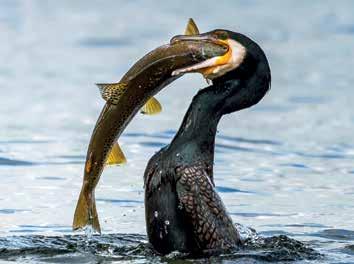
We have rounded up a few excerpts from their own reports:
Longelse Sønderskov, LangelandCould there really be GOLD(fish) at the end of the rainbow? With Freya on smolt duty in the rain and sleet. There were five huge seagulls circling around at the mouth of the river. But Freya chased them far out to sea”
 Daniel R. Stæhr
Daniel R. Stæhr
Viby Å

My wife and I decided to support this great ini ti ative that Havørred Fyn organised to protect the tiny smolt being released into watercourses large and small across the coasts of Fyn. I hadn’t actually been fishing on the coast since 2017, so I was definitely overdue a visit to the beautiful Fyn coast! We decided we should give back a little now that we were once more drawing benefit from this beautiful area and its sea trout”
Michael MøllerTange å
Good morning from Tange Å. At 05:30, we chased six herons away from the mouth of the river, and after that we were by and large alone. By the way, standing guard at sunrise is a really nice experience.
Claus E. ChristensenFact box: Smolt guardians can sign up for different positions and choose for themselves where they want to stand guard.

Just as it has many times before, Havørred Fyn is leading the way for the rest of Denmark. Work is now being undertaken to spread the smolt guardian phenomenon to the rest of the country. This is being done via the FishinginDenmark page which is a part of the national angling strategy. Work is being done to create a common platform where volunteers can register for different positions all across Denmark. In 2023, Havørred Fyn will continue to coordinate the smolt guardians on Fyn and the Islands.
Would you like to be a smolt guardian in 2023? Keep an eye on our website www.seatrout.dk and on our social media pages.

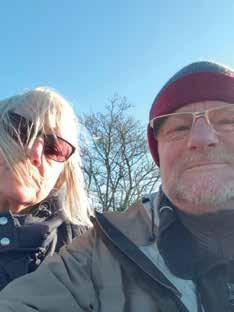

Over ten years ago, the Gravel Gang was all systems go. Wheelbarrows, shovels and grips were being worn out just as quickly as the watercourses on Fyn were being restored, and in 2012, the Gravel Gang was awarded the Danish Sportfishing Association’s Environmental Prize. The Gravel Gang was set up by Vandpleje Fyn with Søren Knabe at the helm. It was for everyone with an interest in our watercourses, no matter whether you were an angler, a bird watcher or something else altogether. It gave people an opportunity to volunteer and make a real difference to the watercourses and natural world in Fyn.

The phenomenon quickly spread to other parts of the country, and the Gravel Gang garnered great success and recognition for their initiatives and efforts. As the years went by, the group’s activities went into decline, and soon after the onset of the coronavirus pandemic, their equipment trailer was left largely unused.
But that has now changed thanks to a new collaboration between Havørred Fyn and Vandpleje Fyn. In autumn 2022, these two organisations came together to revive the formerly successful Gravel Gang which, from that moment on, would now be known as Den Fynske Grusbande – The Fyn Gravel Gang. The values and mission statement remain the same as before, namely to improve our watercourses.
Volunteer Coordinator at Havørred Fyn, Søren Knabe, was taken on at Havørred Fyn in

A new collaboration between Vandpleje Fyn and Havørred Fyn has resulted in the revival of the former’s old Grusbande initiative – the Fyn Gravel Gang. The group will now go by the name Den Fynske Grusbande.Havørred Fyn Secretariat & Lars R. Petersen, Vandpleje Fyn.
2021 after 12 years with Vandpleje Fyn. His job is to prepare the new projects which are then undertaken by Vandpleje Fyn. The driving force and muscles behind the project are the many volunteers who help in its practical implementation. Their efforts help to create better conditions for sea trout in local watercourses, which ultimately contribute towards better conditions for coastal sea trout fishing that we all can enjoy.
As a volunteer coordinator, my most important task is to make sure that Grusbanden always has something to be doing. My job is therefore to constantly seek approval from the authorities for a range of different projects. Meanwhile, it is primarily the chairman of Vandpleje Fyn and project coordinator Lars R. Petersen who, together with the other project managers at Vandpleje Fyn, takes responsibility for project execution.”
-Søren Knabe, Volunteer Coordinator, Havørred Fyn.
Søren is a self-taught water conservationist with a background in the restoration courses offered by DTU Aqua. Over a span of thirty years, he has worked with local angling associations, EVERYTHING relating to water management and as a Nature and Environment Coordinator for the Danish Sportfishing Association. It is safe to say that Søren is the saviour of a great many sea trout in and around Fyn.
Vandpleje Fyn and Havørred Fyn
Vandpleje Fyn is a voluntary organisation comprised of 23 recreational fishing organisations under the Danish Sport Fishing Association. Like Havørred Fyn, Vandpleje Fyn was established with the aim of putting more fish into our local waters on Fyn. Despite their comparable names, the two organisations are in fact quite different. Vandpleje Fyn is comprised entirely of volunteers, primarily anglers who volunteer through their associations. The work of Vandpleje Fyn consists of practical tasks such as electrofishing as well as smaller restoration projects and similar.
We are a voluntary association and we depend on other volunteers lending a hand. We typically announce our projects via the Vandpleje Fyn Facebook page and get help that way. Everyone is welcome. The streams and rivers of Fyn are our passion project. We protect our watercourses in the hope that we can leave behind a better and healthier landscape than what we inherited. It is tough and time-consuming work restoring nature to its optimal condition, but we do it with a smile on our face.”
- Lars R. Petersen, Chairman of Vandpleje FynVandpleje Fyn has its own board which works independently of both Havørred Fyn and Fyns Laksefisk.
Havørred Fyn, on the other hand, is a joint municipal project that is tasked, among other things, with improving local sea trout stocks and, through this work, ensuring more revenue from fishing tourism and creating jobs in waterside areas so that we have more capital to restore yet even more waterways. Havørred Fyn, Vandpleje Fyn and Fyns Laksefisk work closely together, especially around electrofishing in the autumn, stocking releases in the spring, and now on the Gravel Gang.

The new Gravel Gang has already had their first projects. Most recently, on a cold autumn day at the end of November in 2022, ten volunteers came down with coffee and rolls to assemble by Storå in the north west, at a sewage treatment plant next to the stream. Søren Knabe and Lars R. Petersen worked to direct their many helping hands, and both gravel and hiding stones were set in place by the volunteers. Spirits were high, for this was a particularly sorry-looking stretch of Storå that was in much need of a loving hand. The Gravel Gang brought along all the materials and on this occasion that even included a skid-steer loader which was used to transport the gravel and stones from the car park to the water. However, as always, it was the volunteers – with their shovels, rakes and wheelbarrows – who proved the key element, for not one single stone was placed at random in the stream. This is where the Gravel Gang excels, after all, and their task was to place gravel, hiding stones and dead wood. They also plant water plants and remove sand from spawning banks. The result at Storå was four incredible new spawning banks and loads of large hiding stones along a long stretch.
Joining the Gravel Gang is free and does not involve any kind of minimum commitment. It is entirely up to you how much you want to contribute, and you only have to participate when you have the time and the inclination. To get involved, simply join the Facebook group called Den Fynske Grusbande.
Lending a hand to our waterways is of course voluntary, but it often brings good karma. And that is exactly what happened that Sunday at Storå. Participants got a pleasant surprise when plot owner Allan Madsen from Hårslev was so impressed by the gang’s work that he invited all participants to enjoy a free week at his fishing lodge by Vefsna, which is a very well known river for salmon fishing in Norway.
At the beginning of November 2022, Assens Municipality undertook a restauration project at the little watercourse by Turup with support from Havørred Fyn (Sea Trout Fyn)
It all began one autumn day in 2021, when a plot owner with an interest in a small watercourse by Vistorpdam got in touch with the municipality to find out if there was anything that could be done for the stream on his land and the fish within it. Fortunately, there are many such plot owners on Fyn. The municipalities receive many inquiries from landowners who are interested in supporting nature and improving conditions for both sea trout and our watercourses.
It is a very positive development to see an increased focus on having good conditions in our watercourses. Here at Havørred Fyn, we consider it to be very important that watercourse improvement projects are implemented in conjunction with local plot owners. That way, the projects can bring both more fish but also a sense of local satisfaction and cohesion.” - Søren Bay, Stream Biologist and Project Manager at Havørred Fyn. .
The little stream from Turup is about a metre wide and less than two kilometers long. That may not sound like much, but small streams like this are actually very important for sea trout. It is in places like these that adults spawn and
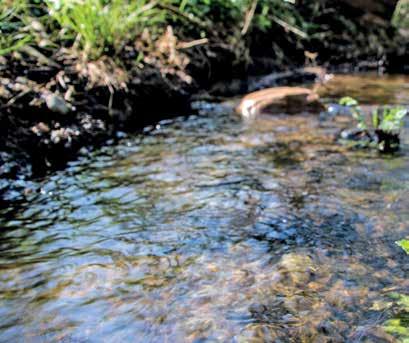
their fry grow, before they begin their migration out towards the salt waters of the sea as smolt.

The small stream is located in the western part of the island and drains into Turup Møllebæk, which then snakes its way further through the landscape towards Puge Mølleå before finally flowing into the Little Belt. The stream has an average drop of about 5%, which is ideal for a trout stream. But just as in many other streams, there is a lack of variation, spawning grounds and large hiding stones where small fish can hide and find shelter from the current.
Turup Møllebæk, which the stream flows into, is a fantastic home for sea trout. It first acquired that status ten years ago, when Assens Municipality and Havørred Fyn carried out a number of projects together with other plot owners in the area. It is now home to both spawning grounds and hiding stones, and in a 2017 study, DTU counted 248 trout fry per 100 square metres in the stream. In the smaller stream at Turup, however, the figure was just 53. So the


words of the plot owner were both heard and understood when he got in touch, and his stretch of water was restored in 2022. Heavy machinery dug up the stream while the Fyn Gravel Gang laid down more than 300 metres of gravel and hiding stones. Passage was secured through a pipe bridge and a piped stretch was shortened by seven metres. Not many municipalities have the funds available to pay for their own waterway projects. However, we are lucky here on Fyn to have Havørred Fyn providing financial support to municipal restoration projects. This means that Fyn and the Islands have a long tradition of restoring watercourses. Over the past thirty years, countless projects have been carried out to ensure passage through our watercourses and to improve living conditions for sea trout through the laying of gravel and hiding stones in many different shapes and forms.
Sustainable sea trout fishing conditions on the coast actually begin far
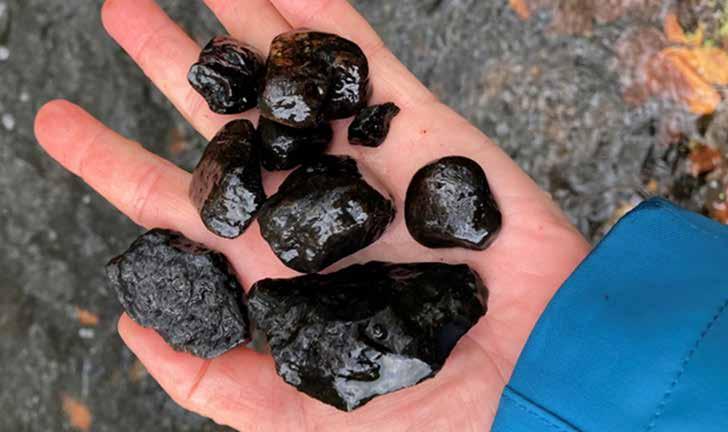
up the river. Financial support for stream maintenance and restoration is crucial to ensuring future generations of wild sea trout. The rivers and streams are already there, we simply need to improve the conditions which in many cases we have damaged ourselves” - Søren Bay, Stream Biologist and Project Manager at Havørred Fyn
When it comes to this type of project, so much focus on sea trout in particular can make the initiatives seem a bit one track. But it is important to remember that good conditions for sea trout also means good conditions for many other species. In fact, sea trout can be used as an indicator species of sorts, especially when it comes to water management work. In short, watercourse restoration benefits not just fish, but also insects, birds and the rest of the ecosystem, too.
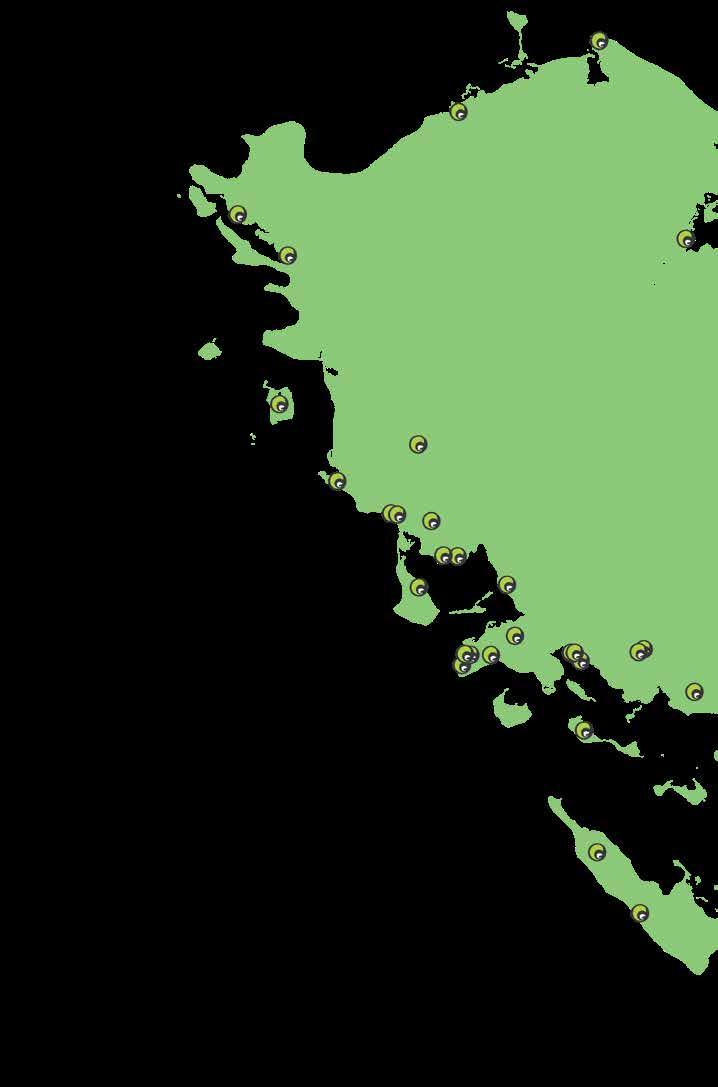
If you intend to fish for sea trout over several days, then we’ve got good news for you and your buddy – you can stay at an angler’s cottage certified by Havørred Fyn and enjoy yet even more time by the water. Along the coasts of Fyn, Ærø and Langeland, you will find more than forty certified lodgings which have all gone that extra mile to make anglers and recreational fishers feel welcome. This means they have spared a thought to all those things that fishing folk value. The hosts have local knowledge about fishing, they can arrange certified sea trout guides, help with fishing licenses, and you can even dry and store your gear!

You can find these certified lodgings at www.en.seatrout.dk and you can also recognise them by their signs: Havørred Fyn Partner.









A free copy of this magazine is available at these fishing stores in Fyn:

A free copy of this magazine is available at these European “sea trout friendly” stores:









Fishing guides on Fyn, Langeland and Ærø
Turbocharge your sea trout fishing: The fishing paradise on Fyn consists of more than 1,100 kilometres of coast spread across ninety different islands. The key to a successful fishing trip is knowing precisely where, when and how to fish for sea trout. The secret is FISHING GUIDES! Havørred Fyn offers fishing guides who are all professionals and certified within none other than sea trout fishing. They have local and up-to-date knowledge on our coastlines and can make a world of difference to your fishing experience.
Prices from:
½ day (4 hours) DKK 2499

Full day (8 hours) DKK 3499
Get to know them at www.en.seatrout.dk
Michael Johannes Nielsen
Tlf.:+4524844422 Email: michael@fwo.dk

Jan Nachtigal
Tlf.: +4528410290 • Email: info@denmarkfishinglodge.com
René Gerken
Tlf: +45 51 89 05 22 • Email: info@renegerken.com
Kenneth Birler
Tlf: +45 40 47 41 67 • E-mail: mail@fishinglodgefyn.dk
Claus Eklundh Christensen
Tlf.: +4527289541 • Email: info@fishnship.dk

Niklas Albrechtsen
Tlf.: +4553576006 • Email: niklas@seatroutguidefyn.dk
Omar Bo Gade
Tlf.: +4528410290 • Email: info@denmarkfishinglodge.com
Fyn and the Islands are a place for all types of sea trout fishers, both beginners and professionals. The prince and the pauper. You will find everything you need here, and you can tailor exactly how you want YOUR fishing experience to be. You can bring along everything you’ll need, buy your licence and strike out on your own. Our you can pack light and dive into the myriad of options that the locals have tailored for you.
A True Buffet of Possibilities
Fyn has optimal conditions for sea trout. Its practical size means it is easy to visit many different and varied fishing areas, all with different conditions, on a single day – from shallow, sandy bottoms to steep and rocky coasts. In the spring, you will often find sea trout in the shallow fjords and open coasts with their ‘bathtubs’ and deeper bottoms, where the sun’s rays quickly warm the water. Autumn on Fyn is also really great. The sea trout change from their appearance of polished steel into their darker spawning colours, so they are prepared for the coming festivities back in the smaller streams and rivers. At this time of year, they are super strong

and in top form.
In the early spring, when the ragworms are swarming, that is when the sea trout fishing season begins in earnest. As the water gets warmer, the fish spread themselves out more and more.
In April and May, food that the sea trout can munch on abounds in all different forms, meaning a great deal of variation for us fly fishers. Faux shrimp like the “Pattegrisen” or the Horny Shrimp, as it is also known, are often a safe bet. But do not underestimate small flies like the “Kobberbassen” (Copper Bully), especially when conditions are calm and sunny. We have experienced this for ourselves when fishing on Fyn. When the sand eels arrive and Fyn is carpeted in blooming yellow rapeseed fields, this is the spring fishing peak for many, and shortly after comes the garfish, which makes for a nice bonus catch.
In the autumn, the sea trout make their way along the coast. They are on their way back to their childhood home to secure the next generations. The water is cooling down again after the heat of the summer, but it is still bubbling with life. Sea trout can be found just about anywhere in these autumn months. From the reefs with their currents on the open coast to the small coves with
their freshwater discharges, where the sea trout prepare for their journey back up the stream. Typically, though, they are to be found sneaking around in the shallowest of waters. So keep your eyes on the surface and remember to fish it clear before you wade out into it.
Where Shall We Sleep Tonight?
Are you heading out on a fishing adventure? Then you should go to Fyn and its island paradise! Personally, I always check out the Havørred Fyn certified accommodation options on www. en.seatrout.dk. Here you will find a wide range of options close to the coast for fishers who appreciate being able to trudge down to the water and cast that first line even before breakfast. When it comes to the class of accommodation, perhaps you’re the princely type who would like to stay in a veritable medieval castle or a modern fishing lodge with all the facilities a sea trout fisher could dream of? Or do you prefer the adventure of a pauper’s life, practically sleeping under the stars in one of Fyn’s many wild shelters? Or maybe you would like something in between, perhaps staying at one of the local bed and breakfasts with their cozy charm and great local food? No matter what you prefer, Fyn and the Islands have
The Danish Sea Trout El Dorado that is Fyn is a dream come true for saltwater fishing enthusiasts. It has everything. Fishing huts, guides and a fantastic coast for sea trout which disappears beyond the endless horizon. Best of all, Fyn and the Islands are just a stone’s throw away from Sweden, Germany, the Netherlands and Norway.Mathias Arnham, Arnham Media & Christian Thomsen, Havørred Fyn.
it all, and the certified lodgings have gone that extra mile to accommodate anglers. They know the local fishing spots. They can offer an early breakfast, packed lunches or a late dinner, all depending on what best suits you and your fishing buddy. They have drying rooms for your waders and you can rinse off your fishing gear when you get back from the coast. And they can even offer certified fishing guides from Havørred Fyn as well!
There is fishing on Fyn 365 days a year,
and there are always opportunities for anglers interested in catching sea trout. But with that being said, your techniques and experiences from fishing for sea trout in other places will not necessary transfer directly to conditions on Fyn. It is a good idea to find out as much as you can about the local fishing spots, techniques, flies and lures before you cast your line into the saltwater.
The book 117 Fine Fynske Fiskepladser [117 Fine Fishing Spots on Fyn] contains all you need to know!

If you come to Fyn or anywhere else in Denmark to go fishing, then you need to remember to purchase a fishing licence. You can do this online at www.fisketegn.dk. A fishing licence costs DKK 185 and is valid for a whole year. The money helps support local improvement measures which ultimately benefit your fishing experience.
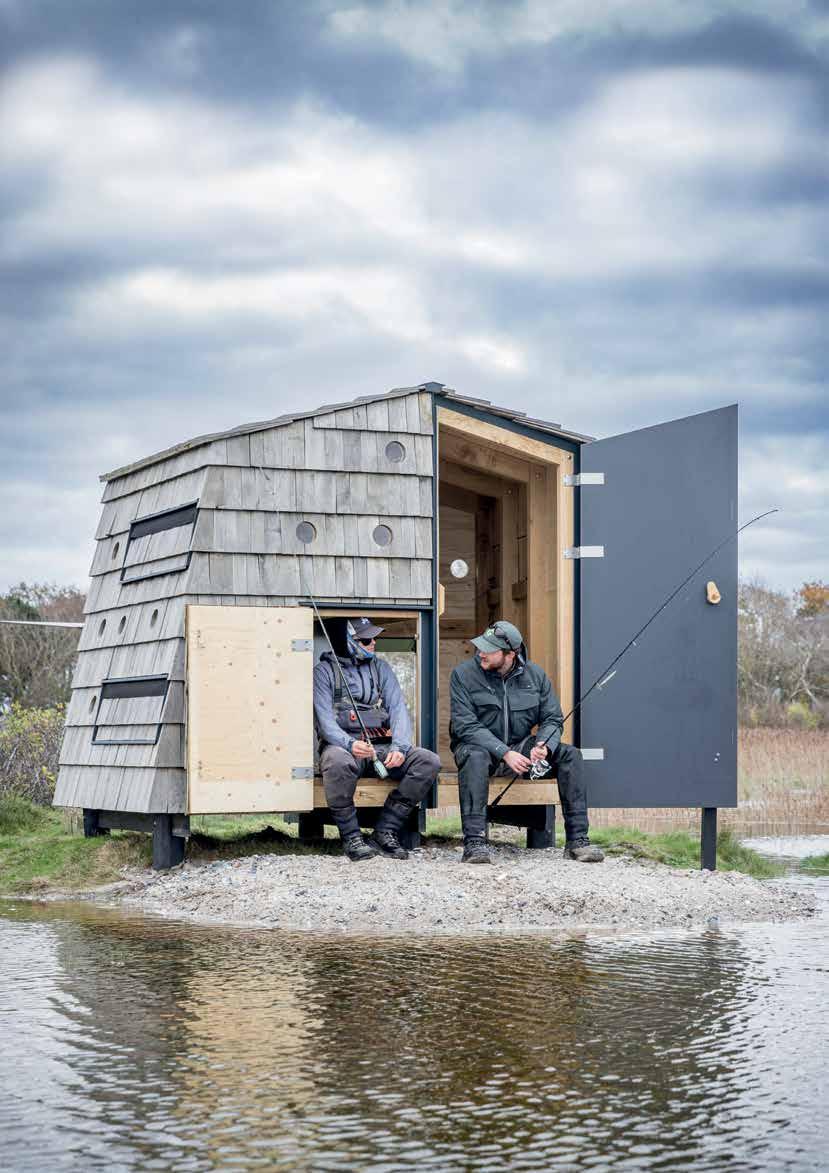
Fyn, Ærø and Langeland offer kilometre upon kilometre of coast just made for sea trout and sea trout anglers. More than 1,100 kilometres of coastline await, with scarcely a single metre where, at some point, a sea trout cannot be caught. But where do you start? Which are the best fishing spots for different seasons? And what about the wind and the current? How do they affect various locations?
Answers to these and many other questions can be found in our guide book to guide you to 117 brilliant fishing spots around Fyn, Langeland and Ærø. Several of the islands’ most experienced saltwater anglers have contributed to the book and share the benefit of their fishing experience. The guide book is full of inspiration for the seasoned trout angler and the novice alike. Good maps and accurate descriptions make it easy to find just the right fishing spot – depending on the season, fishing method and wind direction.
Book contents:

117 coastal spots on Fyn, Langeland, Ærø and the numerous smaller sea trout isles
Lerial photos of every single fishing spot bring a brand-new dimension to fishing.
Fifteen detailed maps with depth contours.
The best season and wind direction for each fishing spot. Useful tips about tackle, strategy and how to fish all year round. Useful knowledge about the sea trout.
Guide to sandbars, reefs, troughs and other coastal features. Ten fascinating stories from some of the spots described in the book.
Buy the book from your local Fyn fishing tackle store
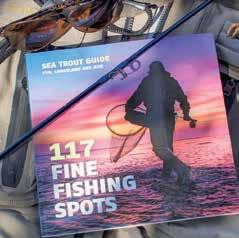

My fishing partner was starting to get on my nerves, and the scene was almost like something out of a bad movie. As we stood out there in the dark of night, him with his spin gear and me with my fly, he said pretty much three things only: “That was a bite”, “there it was again” and “here we go!” Luckily he missed a couple, but he was very quickly on his way from annoying to downright unbearable.
The whole affair began with us lying on the beach in the afternoon sun, sipping on some freshly brewed espresso. There was a young guy standing out in the water who we figured would pack up when it got dark. Then we would be left in peace to fish. He did indeed start wading back in as the sunlight faded, but only to unload his catch. Hanging from his belt were three big beauties: A cod, a mackerel and a sea trout. It would be impossible not to acknowledge such a varied and successful bounty. We praised his catch, offered him some coffee and asked, just by the by of course, what he had done to lure his fish to bite. He gladly showed us his rig on which he had mounted a Gulp Sand Eel. There was no weight or bombarda being used as a float, just the rig and the rubber animal pulled straight out of that foul-smelling liquid. The young man was admittedly just a medical student at that time, but we quickly began referring to him as “Doctor Gulp”.
My fishing buddy was sold from the get-go and sat down by the coffee table when we got home to further develop his rig. He has always called fly fishing nerdy, what with all its hooks and feathers, so I couldn’t help but giggle a bit as I watched his burly, bricklayer’s hands begin tying small, intricate knots. That was really quite nerdy. But the problem was, it bore fruit out on the water. But I tried to ignore that as best I could. This attitude served me just fine, too, until one evening when I decided to bring along a spinning rod because I thought maybe (just maybe!) I might want to try this whole Gulp malarkey for myself. I waded out into the tidal current while my buddy sat and tinkered with his sand eel and his rig. A process that takes as long as it takes. By the time he had finally got his waders into the water, I had been out there for a long time without any luck. The fish probably hadn’t come in yet, I thought to myself. Until my buddy caught a trout on both his second and third cast.
Neither put up a fight and they were both released again, but I had reached the point where I just couldn’t take it anymore. “Get me a sand eel and a rig!” – I had to really control myself not to hiss the words out at him.
It became a very memorable evening and night. I discovered quickly how the sand eel was attacked time and time again. And I soon also learned that it’s important not to react too hastily before feeling the tug. My dry-fly fishing instincts cost me a few on that count. Then came frustration when a garfish assaulted the rig and I had to unravel the whole mess. But that comes with the technique, I suppose. The high point came when I managed to get a little eddy going close to the land, and the Gulp was practically inhaled by a trout measuring well over half a metre. It turned out to be a fun, successful and very intense fishing method.

You don’t cast particularly far using this method. The rig and the Gulp Sand Eel weigh only six grams together, and their wind resistance is pretty good. Use light coastal gear and cast at approximately the same casting length as a fly fisher. Don’t worry, fly fishers do also catch fish as well. Part of the technique is that you should not be bullish, but to cast gently and with restraint so as not to mess up the rig. The foul-smelling rubber critter should glide gently into the water, and preferably with a long spin stop. It will twist and turn in the water and really does look like a proper sick sand eel, as my fishing buddy would say. In flowing tide water, you can let the current do most of the work and
just keep enough contact with the bait to stop it from settling at the bottom. When you get a bite, you need to take things slowly and let the animal drop in the water rather than react hastily. I have gotten used to letting the rod handle rest in the palm of my hand as holding it firmly slows things down a bit. When the tug comes, all you need to do is raise the rod slightly in a controlled counter bite.
The Gulp Sand Eel can get big fish to go completely wild. It is a very special experience to watch a big sea trout whip up a vortex on the surface of the water before then going for the rub-

ber animal like a baleen whale. Often this happens because the fish has hit to the side or simply not quite managed to get the right grip. That is what makes this kind of fishing so intense: Everything happens at a relatively short distance. There is a lot of contact and the fish cast themselves aggressively at the bait. When luck is on your side, there is one very important thing to remember: Always use a rubber landing net – never the classic net variety. That was a lesson I learned through bitter experience. If the fish has only hooked on to one of the treble hooks, and this is usually what happens, then the other will wrap itself thoroughly, and I mean very thoroughly, up with the net. I can
The rig looks complicated to tie at first, but like most things, it can easily be learned. You need to use small treble hooks of around size 8–14, three-way swivels and a screw to put into the nose of the Gulp. I use a 0.38 fluorocarbon. It is neither too thin nor too rigid. Relax yourself, sit down and tie your first rig. And when it all goes to pot, simply cut the rig into pieces and start over again. A failed rig will cost you nothing more than a little bit of line. Start by tying
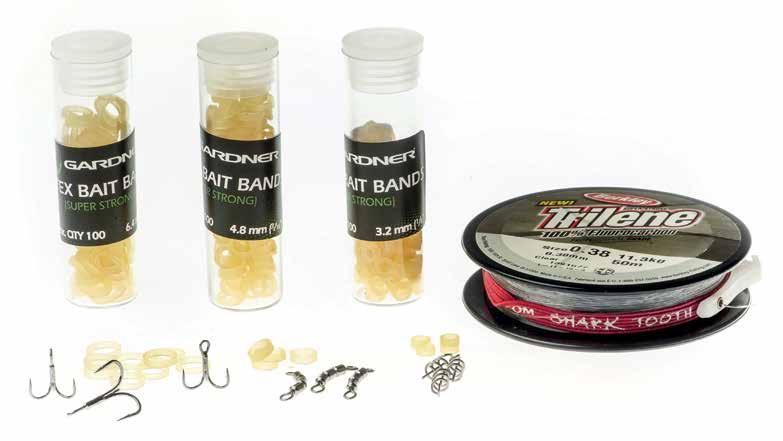
the first hook with a loop knot, so the hook is hanging loose in a little loop. Now comes the tricky bit – namely, tying the screw. You might find it helpful to tie the knot to the point where you are almost about to pull it all together, and



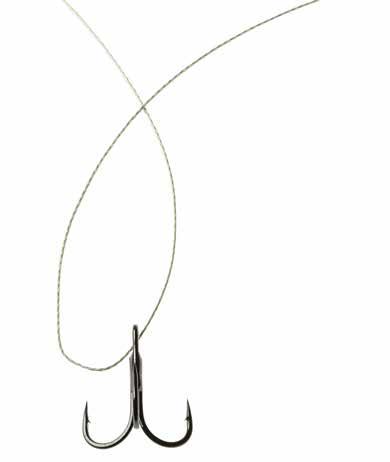
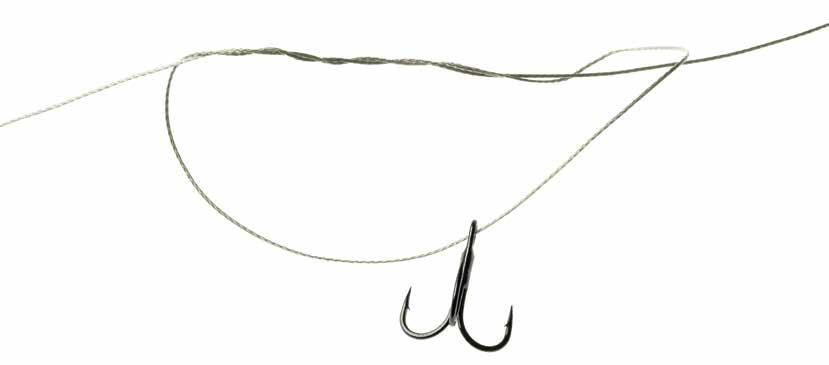
only then introduce the screw into the loop, before tightening it all up. The rear hook should be done in a classic lure knot, and the same goes for the three-way swivel, of course. If your rig turns out too short, don’t discard it.
We’ll come back to this.
tell you, there is very little joy to be found in untangling the whole mess, and besides, rubber is also much better for the fish if you are releasing it again.


Four in a Row
One evening, my fishing buddy gave me a buzz. First to tell me that he had caught two beautiful sea trout. Later on, I got another dramatic account of a 60 cm catch that had bitten at so short a distance that it was basically about to close its mouth around the end of the rod! I offered him my congratulations both times, of course. But by the third time, just two hours after the first call, I must have sounded a tad short on the phone. This time he had just released a fish measuring half a metre, and I really was approaching the end of my tether ... But I got my revenge one evening when he wasn’t able to come out fishing. The message that popped up on his screen was short and sweet. It simply said: “60”. So I may as well admit that I have become a bit of a dabbler and I now take both a spinning rod and a fly-fishing rod with me when we got out after sea trout on spring and summer nights. I guess one must always be prepared for a bit of “Gulp Fiction”.
Dr. Gulp, Mikkel Warming, with a nice trout measuring 64 cm. The fish is proof that using a Gulp Sand Eel does not strictly need to be a nighttime affair, but is also possible in full daylight. At a spot with no current and basically no wind, fly and spinning fishers had been ploughing the waters with their bait all day without success. A Gulp Sand Eel made all the difference, slowly but surely. More than anything, it was a couple of long spin stops lasting 3–4 seconds that really got the fish to take the bait. Mikkel also landed a 60 cm sea trout that day
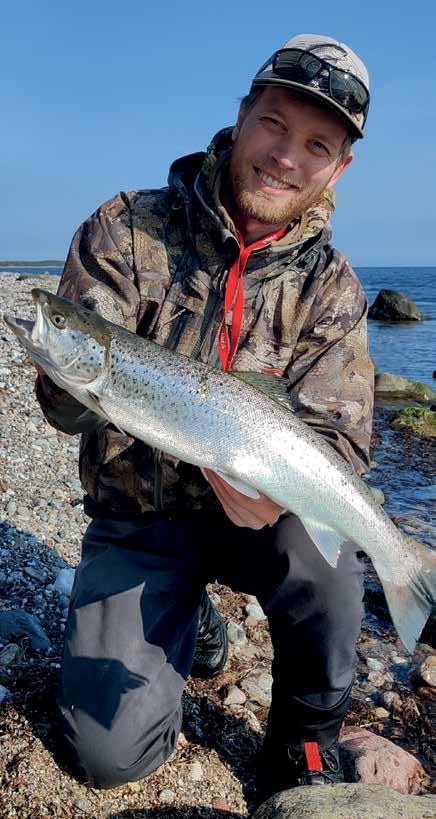


To dream of Ærø is to dream of little cobblestone roads and crooked, colored houses. Of small, sheltered bays brimming with seatrouts. A place where time stands still, and life feels like living in a fairytale. Incidentally, the latter is quite understandable. After all, one of the most famous fairy tale writers, H. C. Andersen, was born on one of the neighboring islands – Fyn. And if you’ve ever been to Fyn, you know that it doesn’t require much imagination to understand where he got his inspiration from.

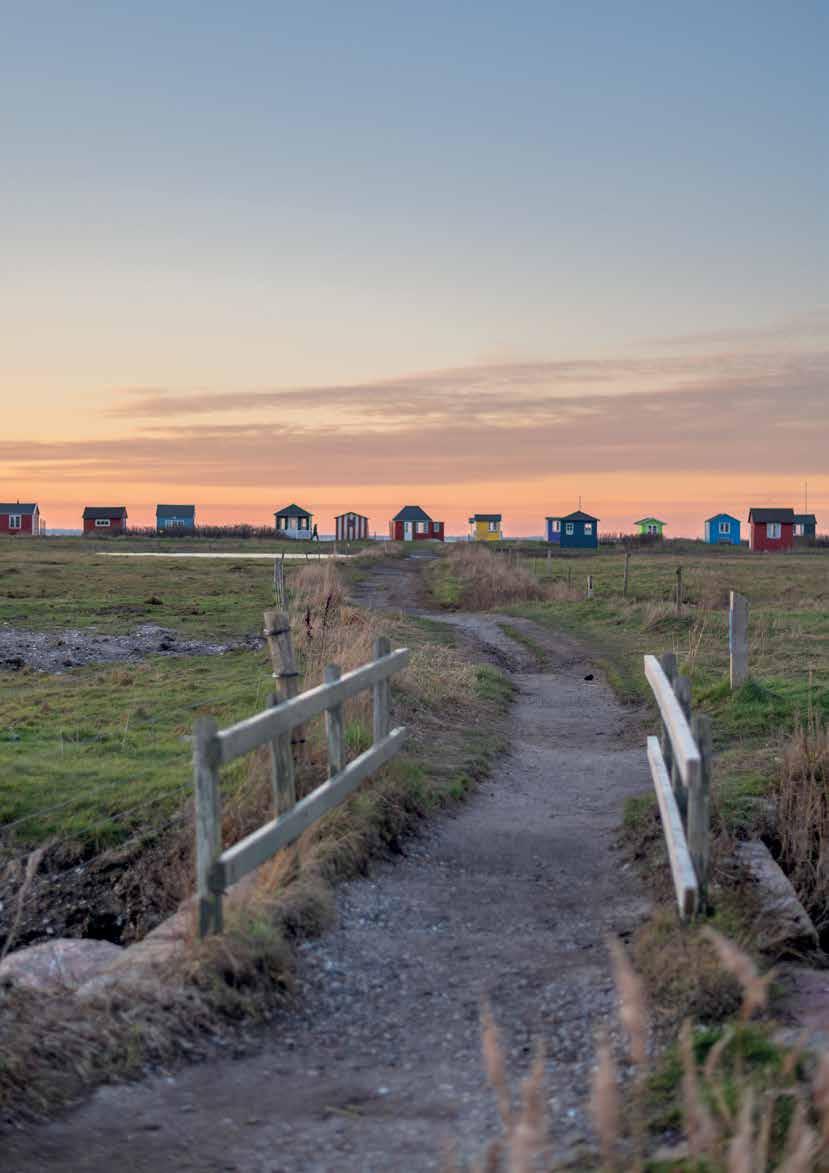
The problem with (day) dreaming is that, at a certain point, you have to wake up. And although I believe that dreams may come true, the reality is that often, they don’t. So, when I contacted Christian Thomsen, the marketing communication manager of Havørred Fyn by phone, and told him about my Ærø dreams, he nodded understandingly. Of course, I couldn’t see him nodding, we were on the phone, but I felt it. He told me that he knew exactly what I was talking about, since he was half being born and raised on Ærø himself. Unfortunately, I wasn’t the only one who was dreaming about Ærø, so we had to change my Ærø dream into a Fyn dream. Which, with the help of Christian, turned into several dreamy days on Fyn.
Facta: Ærø is an island south of Fyn and west of Langeland on the Little Belt. The island has no fixed crossings to other islands or to the mainland. The “Ærøfærgerne” operates ferries from Faaborg and Svendborg on Fyn and Ellen, the world’s longest electrosailing ferry, sails to and from Fynshav on Als. The other ferry, Ærøexpressen sails to Langeland. Ærø covers an area of 88 km², with a coastline of 120 km. Ærø constitutes a single municipality, Ærø Municipality, which is also a member of the Seatrout Fyn Project.

I more or less consider Fyn home, especially the northern and western parts of the island. Even after all these years, my heart still skips a beat when I see the Little Belt Bridge appearing at the horizon. The bridge, soon followed by the friendly
face of Middlefart*, gives me that warm welcoming feeling. From there, depending on the season, I go north. Past Bogense on the way up to Fyns Hoved. Or I take a right and visit the little city of Faaborg and the areas to its north and south. But Middelfart is always a good place to start, especially with a piece of cake from the local bakery in Brenderup. The largest sea trout I have landed on Fyn was 72 centimeters. It was a beautiful September morning... Whoa, back from daydreaming! It is most often The Danish Sea Trout Bible, “117 Fine Fyn Fishing Spots”, that guides me in the right direction and determines the fishing destination in the end anyways.
I caught my biggest fish on the northern part of Fyn. The biggest and the most. This of course raises the question whether the northern part of Fyn is better for catching seatrout than the southern part? The answer to that question is very simple: during my visits to Fyn I spent most of my time, and therefore fished, on the northern part of Fyn; so naturally I caught more, and therefore better fish on the northern part. Simple statistics. I don’t believe in better fishing areas. I believe in searching! And searching implies moving around.
As all coastal seatrout anglers know, finding seatrout is the key to catching them. That sounds almost too trivial to be relevant, but it simply means that you have to keep moving. A common mistake is spending too much time in one place. If I tell you that it is around 800 kilometres from where I live to the island of Fyn, and when being there, it is so easy to change
spots! There may be too much wind at this spot, muddy water at the next, and an abundance of floating eelgrass at the third; or the moon may be wrong, the tides may not co-operate, but I always catch them somewhere at the end.
Although I really like the northern part of Fyn, including my all-time favourite fishing spot, I also have a soft spot for its south-west. Especially in the colder months of the year: from November through March. The area around Faaborg offers some of the best fishing spots on Fyn. Faaborg area I will never forget the first week of January 2016, when I visited the area around Faaborg. When I arrived, on January 2, and collected my cabin key at a local SPAR supermarket, it was about +8 °C. When, still a bit sleepy from the long journey the day before, I opened the door the next morning, to take the dog for a walk, I immediately closed it again. During the night, the temperature had dropped to minus 6 degrees C and yesterday’s breeze hard turned into a fullblown storm. Temperature and wind together resulted in a wind chill of about minus 18 degrees C. The weather stayed more or less the same all week. Which led to the most incredible scenery, and because of the many (sheltered) options the Faaborg area has to offer, to some of the best fishing I ever experienced!
Driving to Torø Huse always puts a smile on my face. I just can’t help it. There are so many good memories associated with Torø Huse, that I wouldn‘t know where to start. I could
tell you about the first time I discovered, with a little help, the reef, and saw several enormous seatrout jumping, quite out of reach. Or about that time when I had to wade out, and out, until slowly but certainly, my waders filled up with ice-cold water, to reach a fish I spotted (I did, in the end, catch it). Or that day in spring when everything seemed to come together, and I caught 3 beautiful seatrout over 50 centimetres, at a spot they call ‘the cross’.
I already spent nine hours ‘fishing’, of which at least 7 were spent behind the wheel, and I didn’t catch a thing. On one side of the island the water was too murky. On the other side, the wind was too strong for fishing with a fly rod. I tried several sheltered bays, but those were all filled with enough eel grass to weave a basket from. I don’t get frustrated easily. I always feel blessed just to be here. But it is fair to say I have had better days.
When Aart-Jan arrived on the third day (I was very fortunate that he agreed to be ‘my’ pho-

tographer for the upcoming week) we went out together after lunch. We parked the car at a spot I had visited the day before. Yesterday it was impossible to make a single cast due to the blustery wind. When I headed out to the water, it was not only gin clear, but the tide was perfect as well, and the wind was just a gentle breeze. Just enough to make the turquoise water ripple. Heading back to the car, a young Danish fly angler walked up with me, and asked where we were from. Aart-Jan told him, and after a slight hesitation, he advised us to walk all the way to the first trees on the outermost corner of that little bay. He had spotted some decent seatrout there but since he only had a lunchbreak’s worth of time to make a few casts…
We started just in front of where we had parked the car. We waded while casting, as we slowly made our way to the spot the local had pointed out to us. Along the way, we caught a few small seatrouts, and after
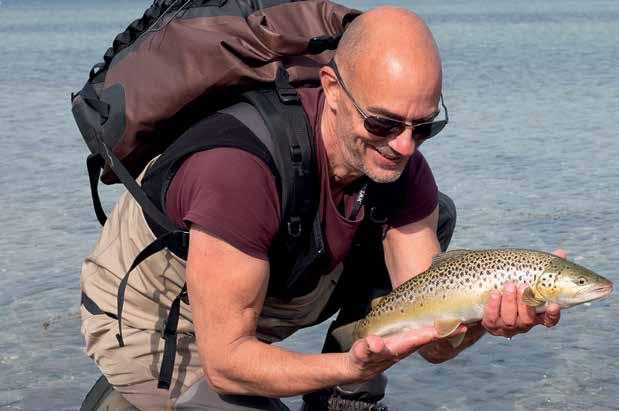
a short coffee break in a perfect (seatrout) scenery, watching a young sparrow hawk hunting a mouse, I headed over to that spot. A mere 10 casts, and I felt a sudden weight on the line. I set the hook and immediately felt this was a good fish. No jumping, but a steady and strong run back towards the vegetation I took her from. I needed this fish, and it was an absolute honour to catch her. We took a quick “keep them wet – photo” and released her again. Slowly but surely, she made her way back to the safe green spot in the azure sea. Following her with my eyes, I was once again convinced that the release is just as beautiful as the catch.

Sometimes I still dream of Ærø. I dream a lot these days. And not all dreams are nice. That is why a week on Fyn is important. It can and will completely release a person from their daily worries. By pure coincidence, I was born in a place on this earth where taking a break is still possible. And if I could spend each of these breaks on the beautiful Danish Island of Fyn, I would be a happy man, and an even happier fly angler.
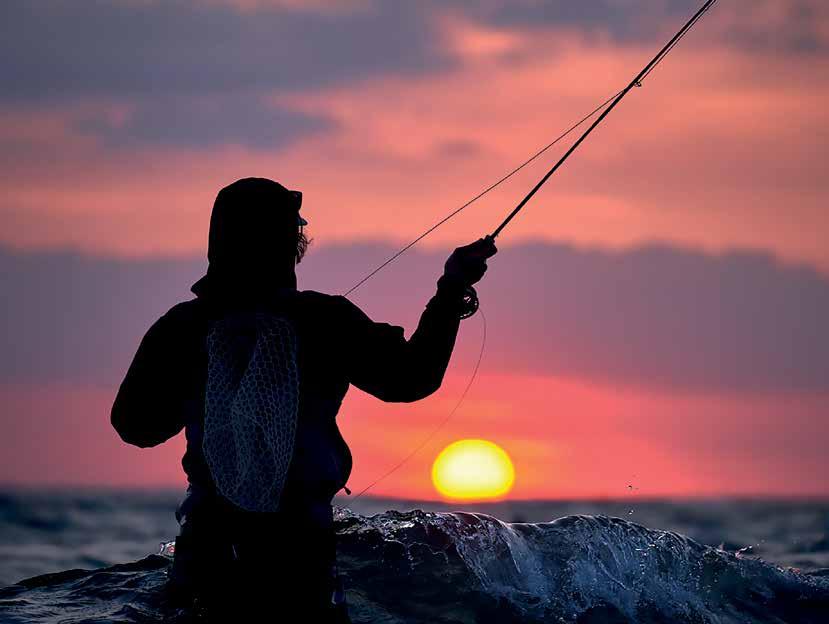
There is nothing like coastal fishing at night. No other discipline requires such concentration or so finely attuned senses. If suddenly a large trout goes for a fly on the surface of the water, you lose all thoughts of the world around you.

Jeg I stand on the reef with my eyes closed. I cannot let anything distract me from my ability to hear. On this particularly dark night, my ears provide me with invaluable information. Even on such a still night, I must filter out the sound of the small waves rippling on the open coast. Can any sounds be discerned beyond the noise of the waves? I get a surprisingly clear response: Off to my right, the

sound is clearly louder. I look to see if I can make anything out in the dark, but the action is unfolding in the wrong direction. To my left, the last remnants of dusk – now two hours hence – are leaving a faint glow on the horizon that I might see something in. That said, to my right there is only darkness. I don’t know of any other type of fishing that fascinates me like fishing for sea trout on the coast by night.
When you tune in to the noises and pay heightened attention to the fading light, the world becomes smaller. All that seems to exist right now is the coastline in front of me. Even thoughts seem to cease when you have to rely so heavily on your ears. All on his own, the fisherman on the coast sees the sea and its inhabitants with entirely different eyes at nighttime. The way the sea water glows in the summer
it easier or harder for fish to be successful in their hunting. In general, I prefer – and seemingly so do the trout – calm conditions and at least some amount of light. Many times, under such conditions, I have stood amidst feeding trout – the only reason trout venture out of the bladderwrack at night is to eat as much as they can!
makes the ordinary Baltic Sea look like a foreign planet. In this world with all its challenges for the senses, you can catch wonderful trout – and this is especially true on the surface!
During my time spent at night on the coastline, I noticed that even within darkness, even the word “dark” can have a variety of meanings. How dark a night actually is, depends on the position and phase of the moon, the time of


year, cloud cover and the presence of artificial light. Trouts are very sensitive to these subtleties, and I give a more detailed explanation below in the text. First, the following principle is the most important: generally speaking, trout can see well at night and feed quite well too, but they reach their limits on particularly dark nights. The weather, especially water movement and surface disturbance from waves, can also make
But why don’t they just eat during the day? - one might ask... The simple answer is: they eat – when they can! In summer, however, the daytime conditions on the coast are often not ideal for hunting. Clear water, bright sunshine, abundant vegetation (hiding places for prey) are not the ingredients for a successful hunt. However, since the water temperatures are also high, the sea trout’s metabolism is running at full speed – and it needs a ton of energy. Since many creatures that trout prey on do venture out of their hiding places at night with some even careless enough to feast on the particularly nutritious film on the surface water, this means that the hunters’ hour has now come. Against the backdrop of the bright sky, the silhouette and movement of the prey are clearly visible. On some nights, the combination of hunger, high water temperatures and plentiful prey makes for a real feast, with some trout jumping a full meter out of the water.
I try to approximate the direction and distance of the noise, then I start to cast and let a good 20 meters of my fly line slide through my fingers. I can only guess that the line, including the leader and the weightless fly, has dropped down silently and, most importantly, stretched out. Very slowly and evenly I begin to strip in the line. Leading the fly in the dark requires one to concentrate and listen intently. My surroundings are seemingly picking up on my tense inner state. I am one with the sea, feel the movement of my fly on the surface, hear the sounds in the rings as the diameter of my line changes. But for now, no pleasant surprises. I’ve almost got my leader in the rings when I hear a soft gurgling sound right in front of me. I look deep into the darkness and do indeed spot a ring moving in a different direction. Immediately my fly lands softly in the center of the ring. At least I hope so, because my vision is quite limited. Again, I slowly begin to retrieve the fly. But again, nothing. This can be quite aggravating: You are standing amongst tons of fish and the sea trout – not exactly a squeamish creature – is decidedly rejecting what you have to offer. Night fishing in particular, trips up many seasoned sea trout anglers.
If you see a trout on the prowl in front of you by day, the take is all but certain. At night though, it’s an entirely different matter. Figuring this all out took me quite a bit of time – not that the learning is over – before I was able to discover a few regularities in their nighttime behavior. Since this article is intended to be a broad overview of night fishing, I cannot go into too much detail on this topic for now. A simple, but quite useful rule is that: Less light – less speed! Believe me: many hours of frustration went into discovering this relatively simple principle. As a coastal angler, one really has to get used to being gentle in the fly control, and even what feels slow is often still too fast...

On really dark nights and with super discreet fish, I seemingly move my fly in slow motion, sometimes just giving it a tug and letting it drift.
The best fish of the year I have to change something! The cast was on target, the fish certainly caught eyes of the fly. But there’s something it doesn’t like. I threw my line in the same direction as before – again only ten metres out. But before I started bringing it in, I waited four, five seconds. A
soft splash right where I suspect the fly to be makes my pulse jump. Instead of raising the rod, I do a quick, long strip, a little pull on the line, then a bit more. I pull the rod to the side, and it’s now fully bent! In the darkness, I hear the full splash of a tail hitting the water. All my tension disappears: it worked! A seemingly good-sized fish plucked up my fly – while stationary – from the surface. The resistance is fierce, and my entire line whistles through the rings. Far out I hear the fish slap the surface of the water again. But the hook has a firm hold, my 0.25mm mono leader leaves little room for doubt in this regard. A few minutes later, the fish is just in front of me, and I can simply scoop it – shaking wildly – with my net. Only as I wade towards the shore, do I switch on the headlamp and look at my catch. Covered in bladderwrack and with water pumping through its gills, there she is: perfectly round and 50-some centimeters long, with a blue shimmer running down her back. This fish is perfect, it gave me a wonderful experience – full of gratitude, I quickly released her back into the dark water.
A fish appeared in the shallow water in the bladderwrack. Thanks to the moonlight, the author was able to place his fly accurately. Now he guides it through the trout hunting grounds with the utmost concentration.
In general, the fish themselves are a great side catch of summer fishing! At no other time of the year would you find so many fat and fit sea trout on the coast. After a tough winter, these fish are in good shape again, the silvery fish of the spring are round and veritable silver bullets and those river-running trouts in the autumn have hardly formed any spawning suits yet, they too are in top shape. But despite the perfect conditions of summer, we should practice moderation! Once one finds a spot with good fishing, it often runs good for weeks and brings great fish on demand. Even if we only take one fish a day, it can still be quite nice. Many of the splendid summer trout start to change color in July and August, thus hinting at what they will be up to in a few weeks.

There was one now! While the fishermen are checking their mobile phones to make sure they are in the right place, a noisy trout on the prowl confirms this for them.

Catching fish at night doesn’t require exact imitations. What is crucial are the size, approximate silhouette and most importantly the movement of the fly! In most cases, the author gets by with these four models and a number 5 floating line.





We should let some of them have that chance.
To my mind, the matter of which fly to use at night is simple to determine. Depending on what one is looking to catch, I use models with hook sizes 4 to 10. You can catch fish with dark patterns, but also with bright ones. Black is good, but this probably matters more to the fisherman than to the fish. The patterns themselves are not complicated. I like to use a Gurgler, but on some nights, the fish prefer flies that go a little deeper below the surface. Simple flies with little tails and body hackles over amply dubbed bodies will catch their part. Another simple but often applicable rule: The louder, faster and more boisterous the trout hunt on the surface, the better surface designs like Gurglers will work. However, all my night flies are weightless because I am convinced that the trout catch most of their prey on the surface in the summer. This hunting behavior already points the way to the night trout. Unlike during the day, fishing at night is very rarely blind fishing for me – despite the darkness. On the contrary, just like when I was fishing for mullets on the coast, I only fish when there are fish in the area. But since you can’t usually see much at night, it’s like in the scene described at the beginning: I wait and listen. On many a summer night, I basically didn’t cast the line out at all because I simply didn’t hear any fish. Were they not there or simply not active? I don’t know. Whatever the case may be, I don’t enjoy fishing blindly in the dark. If I don’t hear anything, I keep walking, if I don’t hear anything after some distance, I change places. This can take on real proportions: some nights I listen along five, six or more stretches of coast –without even putting the fly in the water once. This is of course quite an extreme
approach. You can also go to a wellknown, good summer spot and fish, listen every now and then and fish again. Most good spots will have a fish passing by as dusk and night set in – and some will go for your fly. Here, everyone is on their own.

But what is a “good summer spot”? In the literature, one reads that summer spots are, for example, reefs with a lot of currents and coastal stretches with deep water under land. In fact, I’ve had good catches at times like this, but especially in the hour or two after sunset and at the onset of dawn. In the middle of the night, however, I often prefer coastal spots that would otherwise not be customary in the summer. Channels, shallow mussel reefs and above all shallow water areas are the places where I prefer to be at night, but currents and somewhat deeper water should at least be nearby. In these places, I usually find either quite a lot of fish or none at all; the spots are either teeming with fish or have none at all. In fact, it often happens that the activity is confined to a very limited area within a given zone. It’s easy to explain why the trout roam around here in the dark: there’s plenty of prey in the shallow water with structural diversity. Some soil types, especially some aquatic plants and substrate particle sizes, are host to certain forage animals that are more active than others at one time of the year or another. In summer, many of these little animals are more active at night than during the day. In addition, when the sun is shining and the water is clear, the trout simply cannot reach their prey in the shallow water. At night, this is not an issue. The trout does not shy away from even the shallowest water, and their victims cannot catch on to them in good time. In my opinion, the most important prey to imitate at night are shrimp, copepods
and worms. As already mentioned, it’s not about making the imitation visually plausible – what matters is their size and, above all, movement on the water surface!

Since all night fishing like mine is highly dependent on prey availability and activity, it is only logical that it is restricted by time. The food animals sometimes only have short phases of activity, which are in the hour or two after dusk.
A very active trout showed up several times in the water, which was only 30 centimetres deep, and ended up eating the wrong prey.
However, it can also happen that they swim around all night long and offer themselves to the trout on the surface. On such nights, the trout often only stop feeding at dawn. Since I can’t bring myself to leave when the fish are active, I fish straight through until morning. I used to be able to take that in stride, but now I need a few nights’ sleep to get back on track. That’s a price, however, that I’m happy to pay – for me, very few fishing experiences can rival the intensity of surface fishing at night on the coast.
Almost the best thing about summer fishing is the fish. Never throughout the course of the year do you catch nicer and stronger sea trout.
This article was made in collaboration with Fliegenfishen, part of JAHR MEDIA, during a presstrip in 2022. As always, a professional and artistic narrative with fantastic & beautiful pictures. Havørred Fyn thanks you for the use of this article and all the pictures that make up a large part of the content in this magazine.
See more at www.blinker.de

At night, it’s quite common for a strike on the surface to miss its target. This is often a sign of a fly moving too fast. However, when the fish sit still, that’s usually a good sign. Misses are rather rare here.



